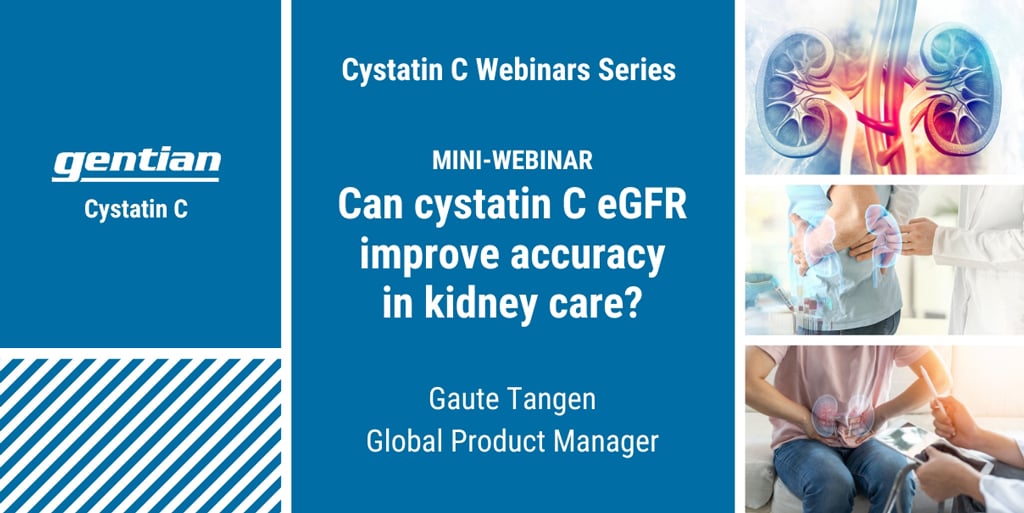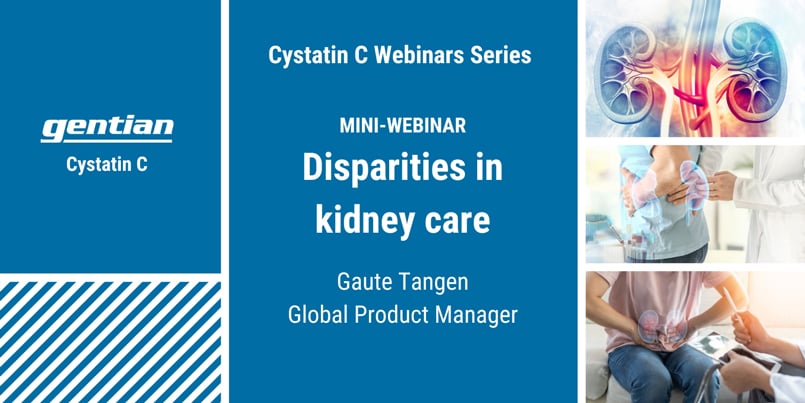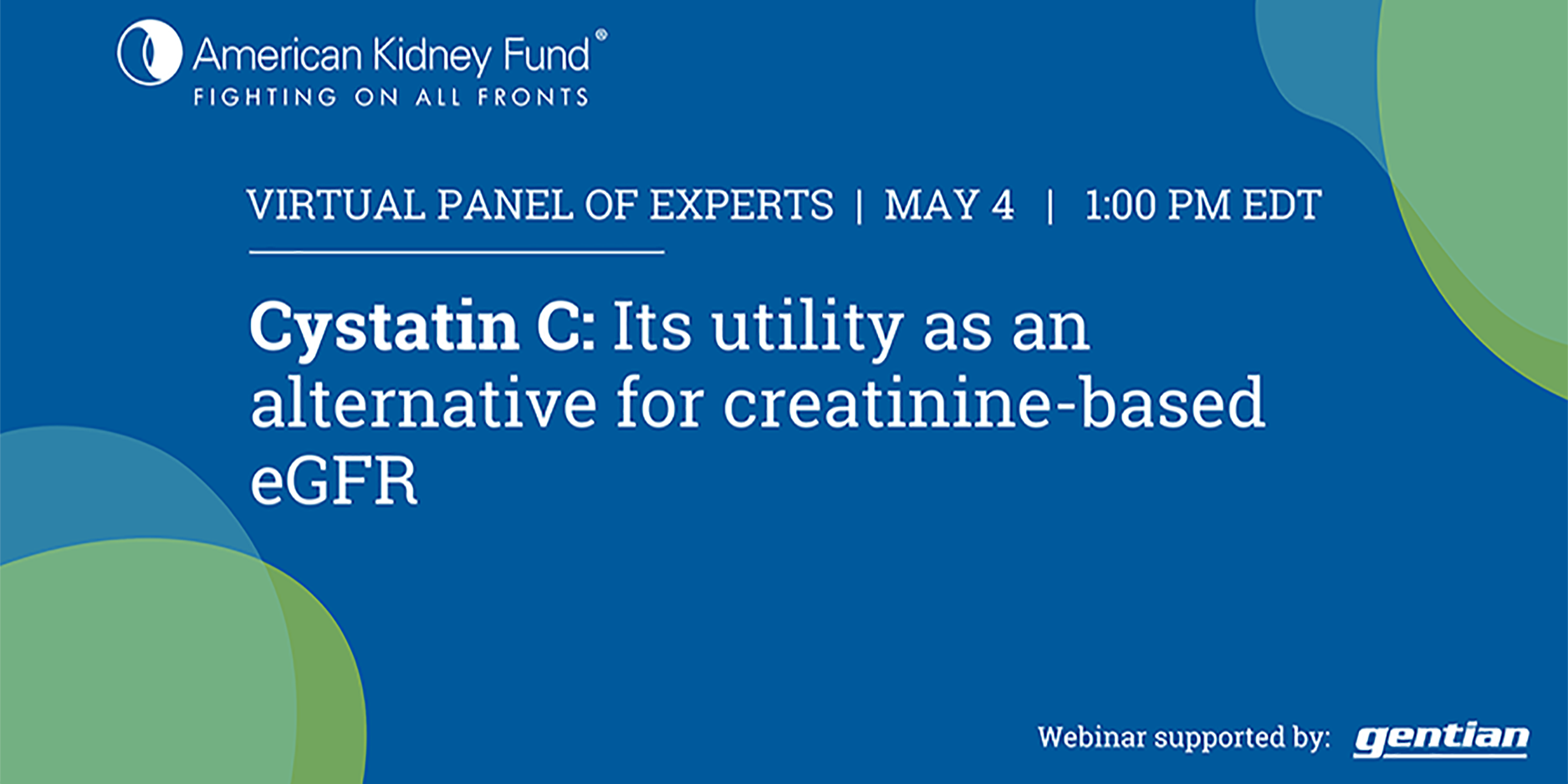CYSTATIN C - as recommended by KDIGO
Superior GFR marker for the diagnosis and therapeutic control of renal function and Chronic Kidney Disease (CKD)
Gentian Cystatin C Immunoassay – Test Kit
Cystatin C is a superior GFR marker for the diagnosis and therapeutic control of renal function1 for patients of all ages . The Gentian Cystatin C Immunoassay (ERM-DA471/IFCC standardised) is an open channel turbidimetric test for quantitative determination of cystatin C in human serum and plasma.
The Gentian Cystatin C Immunoassay is FDA510(k) cleared since 2007 and CE-marked. Cystatin C is now certified by TüV SÜD as complying with the European In-Vitro Diagnostic Regulation (IVDR), EU 2017/746.

Kidney health advocates embrace cystatin C benefits
Clinical guidelines from KDIGO (Kidney Disease: Improving Global Outcomes) recommend cystatin C for enhanced kidney function assessment. In the United States, the joint task force by the National Kidney Foundation (NKF) and American Society of Nephrology (ASN) also advocates for using cystatin C alongside creatinine to confirm eGFR, addressing race disparities in Chronic Kidney Disease (CKD) diagnosis and supporting more precise clinical decisions.
Cystatin C in clinical settings
Established marker
Cystatin C is an established marker for estimating glomerular filtration rate (GFR). GFR calculations performed using cystatin C are independent of protein intake, ethnicity and muscle mass2-5. Equations that include cystatin C predict GFR more accurately than serum creatinine in children6, adults7, and older adults8. Clinical use of cystatin C is recommended in guidelines published by KDIGO2 and NICE3.
Independent of muscle mass
While the clinical use of cystatin C can have far-reaching benefits across all patient groups, certain vulnerable patient populations may experience a greater benefit. Specifically, children, amputees and the elderly would receive more accurate eGFRs with cystatin C because its concentrations are independent of muscle mass and show less age and gender-related variation relative to creatinine2-8.
Precise eGFR for prescribed medications that are renally excreted
Precise eGFR determination is also important in patients who are prescribed medications that are renally excreted. Drugs with a narrow therapeutic index or toxic range can be more accurately dosed when cystatin C is included in the evaluation of the patients’ kidney function. Cystatin C based dosing of pharmaceuticals such as Digoxin, Carboplatin and Vancomycin can lead to better patient outcomes, decreased length of stay and lower treatment cost9.
Technical details
| Assay Performance | |
|---|---|
| Sample type | Serum, plasma |
| Assay type | PETIA |
| Format | Two reagents, ready to use |
| Measuring range | ~ 0.4 - 8.0 mg/L |
| Precision1 | Total CV < 4 % |
| Limit of quantification1 | 0.43 mg/L |
| Security zone1 | 31.13 mg/L |
| Standardisation | Calibrated against the reference material ERM-DA471/IFCC |
| 1Instrument specific, validation results for Roche Cobas c501 | |
The Gentian Cystatin C Immunoassay is FDA510(k) cleared and CE-marked. For more details on Gentian Cystatin C Immunoassay products and prices please contact us at marketing@gentian.com
The Gentian Cystatin C Immunoassay is a Particle-Enhanced Turbidimetric Immunoassay (PETIA) for in vitro diagnostic testing of cystatin C in human plasma and serum samples.
The Gentian Cystatin C Immunoassay is rapidly performed in only 10 minutes and can be applied on a wide range of clinical chemical analysers with documented high inter instrument accuracy.
Compatible with selected clinical chemistry instruments from:
- ADVIA® - Siemens Healthineers
- ARCHITECT® - Abbott Laboratories
- CLIA for Alinity c
- AU® - Beckman Coulter
- CLIA for AU480, AU 5800, AU 680, Immage 800, DxC 700AU
- VITROS® - Ortho Clinical Diagnostics
- BS® - Mindray
- Cobas® - Roche
The Gentian Cystatin C Immunoassay is FDA 510(k) cleared and CE-marked and IVDR certified. For more details on Gentian Cystatin C Immunoassay products and prices please contact us at marketing@gentian.com
The calibrator for the Gentian Cystatin C Immunoassay is available in two versions, one-level calibrator for auto-dilution or a 6-point pre-diluted calibrator kit.
Both types of calibrators are standardised against the international calibrator standard ERM-DA471/IFCC.
The Gentian Cystatin C Immunoassay is FDA510(k) cleared and CE-marked. For more details on Gentian Cystatin C Immunoassay products and prices please contact us at marketing@gentian.com
| Product no. | Product | Content |
|---|---|---|
| 1101 | Gentian Cystatin C Reagent Kit | 58 mL + 10 mL |
| 1019 | Gentian Cystatin C Control Kit | 2 x 1 mL |
| 1026 | Gentian Cystatin C Control Kit | 2 x 5 mL |
| 1051* | Gentian Cystatin C Calibrator Kit | 6 x 1 mL |
| 1012 | Gentian Cystatin C Calibrator | 1 mL |
*Not for sale in the US

Turbidimetric test

Faster throughput

Open channel

10 minutes to result
.png)
Cost efficient
-1.png)
Avian antibodies
Contact us for more information and ordering
Gentian's cystatin C immunoassay is applied to turbidimetry-based clinical chemistry platforms. It is an open channel assay, meaning it can be added to all clinical chemistry analysers.
- FDA510(k) cleared and CE-marked
- IVDR certified
- Developed and manufactured by Gentian
- Manufactured according to ISO 13485:2016
Explore cystatin C in your laboratory - fill out the form or send an email to marketing@gentian.com for more information about the product and prices.
Frequently asked questions
Why can cystatin C provide an estimate of Glomerular Filtration Rate (GFR)?
Creatinine values are dependent on variables including age and body mass and you must correct for this in calculating GFR. Cystatin C GFR gives a direct and accurate measurement of GFR independent of age and muscle mass.
What is the advantage of using cystatin C for GFR estimation compared to creatinine?
Creatinine values are dependent on variables including age and body mass and you must correct for this in calculating GFR. Cystatin C GFR gives a direct and accurate measurement of GFR independent of age and muscle mass.
What is the “creatinine-blind area”?
Serum creatinine values are not a direct measure of GFR. GFR can be reduced by as much as 50% while the serum creatinine value is still within the normal range – this is the “creatinine-blind area”.
Does cystatin C GFR have a blind area?
Cystatin C does not have a blind area and gives an immediate and true measurement of GFR.
How does cystatin GFR compare to gold standards for precise determination of GFR?
Gold standard methods include the use of intravenous injections of radio labelled substances such as Cr-51-EDTA and Tc-99m-DTPA, or iodinated agents such as iohexol. GFR determined as cystatin C GFR shows a direct relationship between the reciprocal of cystatin C concentration in serum/plasma and GFR. Correlation is very good and is not hampered by collection errors or errors introduced by multiple measurements of blood or urine samples.
What is the advantage of using cystatin C to estimate GFR compared to gold standard methods for determination of GFR?
The Gentian Cystatin C analysis can be carried out on one routine blood samples, which can conveniently be done together with other standard tests in clinical analysers. Patients do not have to be invaded specifically for the Gentian Cystatin C test. More importantly, Gentian Cystatin C can replace a range of unpleasant tests, including urine collection or radioactive measurements with repeated blood sampling. Especially for paediatricians, Cystatin GFR is the preferred test method.
How can we get access to the Gentian Cystatin C GFR test?
Please contact marketing@gentian.com for information on how to access the Gentian Cystatin C GFR test in your country.
Is the Gentian Cystatin C Immunoassay available on all clinical chemistry analysers?
The Gentian Cystatin C assay is available on most major clinical analyser. Please contact marketing@gentian.com for more information on availability on the clinical analyser in your laboratory.
Is the Gentian Cystatin C Immunoassay standardised?
The Gentian Cystatin C assay is standardised to the international reference material ERM-DA471/IFCC, and has been repeatedly proven to be aligned with the world standards for cystatin C measurement.
Is the Gentian Cystatin C Immunoassay FDA510(k)-cleared?
Yes, the Gentian Cystatin C Immunoassay is FDA510(k) cleared and CE-marked.
Beckman Coulter Customers
For customer service and technical support regarding Gentian products purchased via Beckman Coulter, please contact your local Beckman Coulter representative.If you are looking for package insert in your own language we have package inserts in a selection of languages.
References:
- Dharnidharka VR et al. Serum cystatin C is superior to serum creatinine as a marker of kidney function: a meta-analysis. Am J Kidney Dis. 2002.
- KDIGO - CKD Evaluation and Management - 2024 Guidelines. 2024
- NCIC Clinical guideline (CG182) updated jan 2015 section 2.1 https://www.nice.org.uk/guidance/cg182/chapter/2-Implementation-getting-started.
- Tangri N et al. Changes in dietary protein intake has no effect on serum cystatin C levels independent of the glomerular filtration rate. Kidney Int. 2011.
- Grubb A. Cystatin C is Indispensable for Evaluation of Kidney Disease. EJIFCC. 2017.
- Björk J et al. Validation of standardized creatinine and cystatin C GFR estimating equations in a large multicentre European cohort of children. Pediatr Nephrol. 2019.
- Inker LA et al. Estimating glomerular filtration rate from serum creatinine and cystatin C [published correction appears in N Engl J Med. 2012.
- Schaeffner ES et al. Two novel equations to estimate kidney function in persons aged 70 years or older. Ann Intern Med. 2012.
- Frazee E et al. Cystatin C-Guided Vancomycin Dosing in Critically Ill Patients: A Quality Improvement Project. Am J Kidney Dis. 2017.
This website may contain information about products that are not registered for use in your country of residence and may not comply with applicable laws or regulations in that country. We do not take any responsibility for accessing such information in those circumstances.




